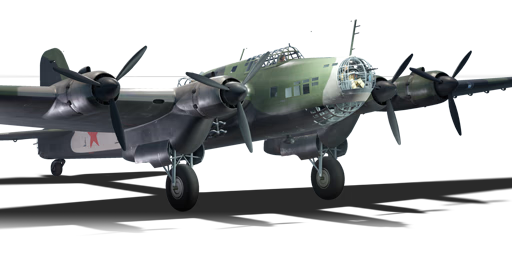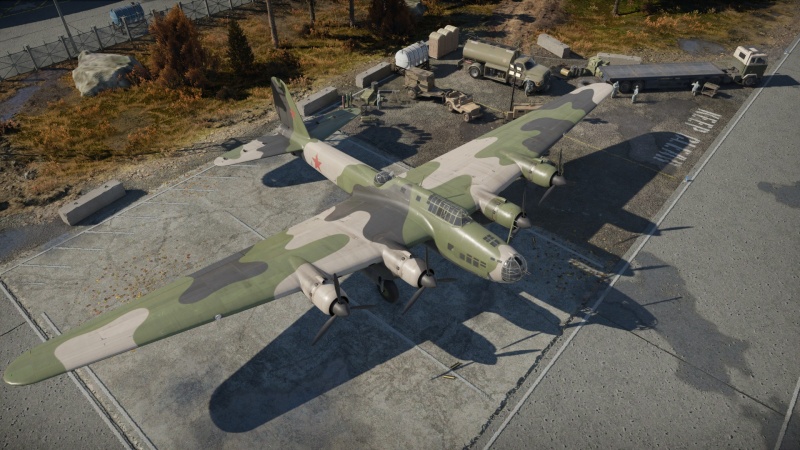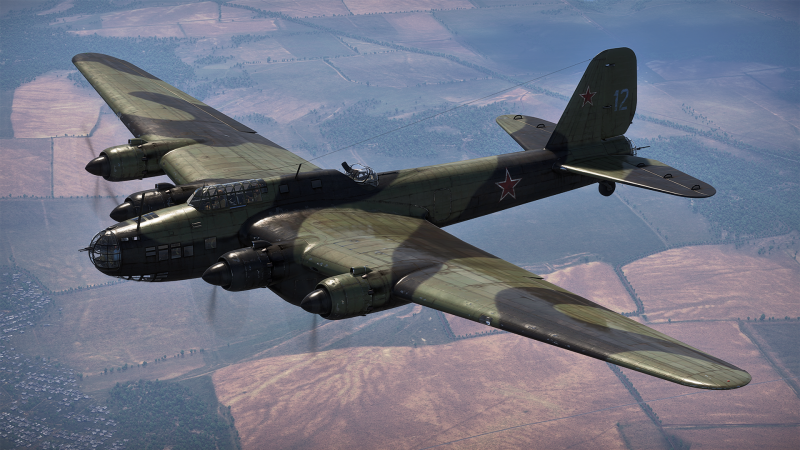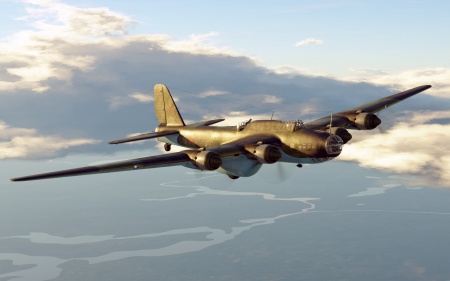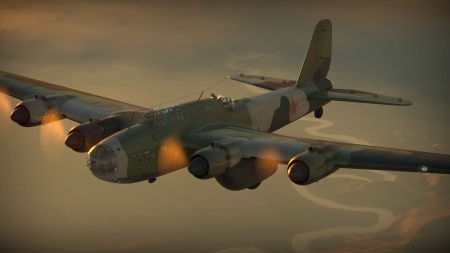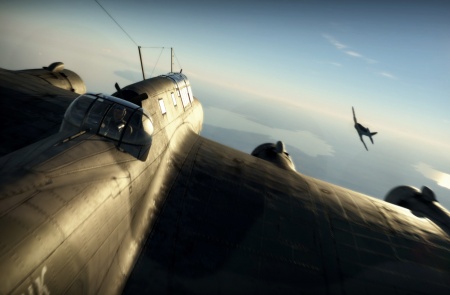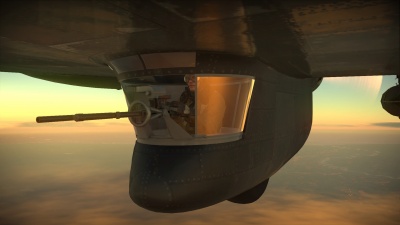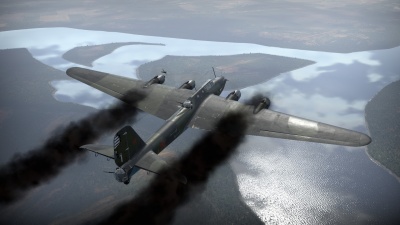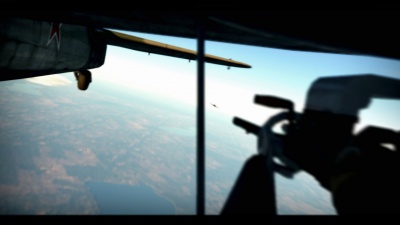Difference between revisions of "Pe-8"
m (Tag: Visual edit) |
U132356605 (talk | contribs) m (→History: I changed the date that it was produced it had said 1339 and i don't belive they had planes in 1339 i changed it to the actual date 1939) (Tag: Visual edit) |
||
| (60 intermediate revisions by 26 users not shown) | |||
| Line 1: | Line 1: | ||
| − | {{Specs-Card|code=pe-8_m82}} | + | {{Specs-Card |
| + | |code=pe-8_m82 | ||
| + | |images={{Specs-Card-Image|GarageImage_{{PAGENAME}}.jpg|ArtImage_{{PAGENAME}}.png}} | ||
| + | }} | ||
== Description == | == Description == | ||
| − | <!--''In the description, the first part | + | <!-- ''In the description, the first part should be about the history of and the creation and combat usage of the aircraft, as well as its key features. In the second part, tell the reader about the aircraft in the game. Insert a screenshot of the vehicle, so that if the novice player does not remember the vehicle by name, he will immediately understand what kind of vehicle the article is talking about.'' --> |
| + | The '''Petlyakov Pe-8''' was an early design Soviet heavy bomber which debuted in 1936. This monster of a bomber was the only four-engine bomber produced by the Soviet Union during World War II. Though impressive as it was, it was only produced in limited numbers and was reserved for special occasions called "morale raids" to encourage and raise the spirits of the Soviet population by hitting important German targets deep behind enemy lines to include bombing Berlin in mid-1941. Other prime targets included the nighttime bombing of factories, German airfields and rail yards. As such an important aircraft to the Soviet people, it became a priority target for the German Luftwaffe pilots to go after. By 1944, all remaining {{PAGENAME}}s were removed from service but were retrofitted for other jobs such as VIP transport and operations up into the Arctic Circle. | ||
| − | + | The Pe-8 was introduced in [[Update 1.53 "Firestorm"]]. Though a large and tempting target, it is not without its merits. The huge bomber has a nose gunner, tail gunner, rear-facing dorsal turret and two rear-facing underwing gun pods. Attacking this aircraft especially from the rear whether above, below or directly from the rear is a bad choice as, like with the [[BV 238]], there are many defensive guns which can hit and hit hard. These defensive weapons are critical to protecting the bomber against inbound enemy fighters, especially because of the bomb payload which it can carry. Options can range between 2,000 and 5,000 kg bomb loads with as many as 40 x 50 kg or 100 kg bombs, or fewer but heavier bombs such as 6 x 500 kg bombs or a single massive 5,000 kg FAB-5000 bomb. The diverse payload options present a wide range of potential targets for the Pe-8, from clearing bases and detonating battleships, to carpet bombing ground defences and clusters of lighter vehicles. | |
| − | |||
| − | The | ||
| − | |||
== General info == | == General info == | ||
| − | === Flight | + | === Flight performance === |
| − | <!--''Describe how the aircraft behaves in the air. | + | {{Specs-Avia-Flight}} |
| − | {| class="wikitable" style="text-align:center" | + | <!-- ''Describe how the aircraft behaves in the air. Speed, manoeuvrability, acceleration and allowable loads - these are the most important characteristics of the vehicle.'' --> |
| − | + | ||
| − | + | The Pe-8 has poor flight characteristics: the plane is very heavy for its engines and thus is slow. This limits its top speed as well as its climb rate. The wings being massive, the turn radius is large and the bomber's manoeuvrability is mediocre. Combined with a short tail, this creates instability and causes the Pe-8 to wobble when changing directions. The bomber usually compresses and wobbles after doing sharp turns, which can be very lethal at low altitude. It can take the pilot a certain time to regain control of the bomber. When engaged in a steep dive, the same phenomenon (compressing and wobbling) takes place, restricting it only to a level bombing role. | |
| − | + | ||
| − | ! | + | Note for new Pe-8 pilots - Since this plane's control surfaces are huge and rotate very slowly, they will have lots of inertia: after you release a keyboard button for rolling, the ailerons will keep deflecting for a second or two before stopping, which is unlike the controls of smaller aircraft where the control surfaces stop deflecting immediately as soon as you release the button. Therefore it is a good practice to release the button a second before the Pe-8 is at an optimal position, as the control surfaces' inertia will do the job after letting go the keyboard input. |
| − | + | ||
| + | {| class="wikitable" style="text-align:center" width="70%" | ||
| + | ! rowspan="2" | Characteristics | ||
! colspan="2" | Max Speed<br>(km/h at 5,900 m) | ! colspan="2" | Max Speed<br>(km/h at 5,900 m) | ||
| − | ! rowspan="2" | Max altitude<br>( | + | ! rowspan="2" | Max altitude<br>(metres) |
! colspan="2" | Turn time<br>(seconds) | ! colspan="2" | Turn time<br>(seconds) | ||
| − | ! colspan="2" | Rate of climb<br>( | + | ! colspan="2" | Rate of climb<br>(metres/second) |
| − | ! rowspan="2" |Take-off run<br>( | + | ! rowspan="2" | Take-off run<br>(metres) |
| − | |||
| − | |||
| − | |||
| − | |||
| − | |||
| − | |||
| − | |||
| − | |||
| − | |||
| − | |||
| − | |||
|- | |- | ||
| − | ! | + | ! AB !! RB !! AB !! RB !! AB !! RB |
| − | ! | ||
| − | ! | ||
| − | ! | ||
| − | ! | ||
|- | |- | ||
| − | ! | + | ! Stock |
| − | + | | 402 || 387 || rowspan="2" | {{Specs|ceiling}} || 36.9 || 37.6 || 4.9 || 4.9 || rowspan="2" | 1,500 | |
| − | |||
| − | |||
| − | |||
| − | |||
|- | |- | ||
| − | |445||422 | + | ! Upgraded |
| + | | 445 || 422 || 35.1 || 36.0 || 10.2 || 7.2 | ||
|- | |- | ||
|} | |} | ||
| − | ====Details==== | + | ==== Details ==== |
| − | {| class="wikitable" style="text-align:center" | + | [[File:Pe-8 lunarrainbow 001.jpg|450px|thumb|right|]] |
| + | {| class="wikitable" style="text-align:center" width="50%" | ||
|- | |- | ||
! colspan="5" | Features | ! colspan="5" | Features | ||
|- | |- | ||
| − | ! Combat | + | ! Combat flaps !! Take-off flaps !! Landing flaps !! Air brakes !! Arrestor gear |
| − | ! Take-off | ||
| − | ! Landing | ||
| − | ! Air brakes | ||
| − | ! Arrestor gear | ||
|- | |- | ||
| − | | | + | | ✓ || ✓ || ✓ || X || X <!-- ✓ --> |
|- | |- | ||
|} | |} | ||
| − | {| class="wikitable" style="text-align:center" | + | {| class="wikitable" style="text-align:center" width="50%" |
|- | |- | ||
| − | ! colspan=" | + | ! colspan="7" | Limits |
|- | |- | ||
| − | ! rowspan="2" | | + | ! rowspan="2" | Wings (km/h) |
| − | ! rowspan="2" | Gear | + | ! rowspan="2" | Gear (km/h) |
| − | ! | + | ! colspan="3" | Flaps (km/h) |
! colspan="2" | Max Static G | ! colspan="2" | Max Static G | ||
|- | |- | ||
| − | ! + | + | ! Combat !! Take-off !! Landing !! + !! - |
| − | ! - | ||
|- | |- | ||
| − | | 535 || | + | | 535 <!-- {{Specs|destruction|body}} --> || {{Specs|destruction|gear}} || 437 || 380 || 310 || ~4 || ~3 |
|- | |- | ||
|} | |} | ||
| Line 85: | Line 66: | ||
{| class="wikitable" style="text-align:center" | {| class="wikitable" style="text-align:center" | ||
|- | |- | ||
| − | ! colspan="4" | Optimal velocities | + | ! colspan="4" | Optimal velocities (km/h) |
|- | |- | ||
| − | ! Ailerons | + | ! Ailerons !! Rudder !! Elevators !! Radiator |
| − | ! Rudder | ||
| − | ! Elevators | ||
| − | ! Radiator | ||
|- | |- | ||
| − | | | + | | < 320 || < 350 || < 380 || > 341 |
|- | |- | ||
|} | |} | ||
| − | + | === Survivability and armour === | |
| − | + | {{Specs-Avia-Armour}} | |
| − | + | <!-- ''Examine the survivability of the aircraft. Note how vulnerable the structure is and how secure the pilot is, whether the fuel tanks are armoured, etc. Describe the armour, if there is any, and also mention the vulnerability of other critical aircraft systems.'' --> | |
| − | + | ||
| − | + | The Pe-8 has a durable airframe, meaning the bomber can take some damage, still complete its mission and make it home. Even if its fuel tanks are self-sealing, fires tend to be devastating for the structural integrity of the wings. | |
| − | |||
| − | |||
| − | |||
| − | |||
| − | |||
| − | |||
| − | |||
| − | <!-- | ||
| − | |||
| − | |||
| − | |||
| − | |||
| − | |||
| − | |||
| − | |||
| − | |||
| − | |||
| − | |||
| − | |||
| − | |||
| − | |||
| − | |||
| − | |||
| − | |||
| − | + | ;Armour plates | |
| − | |||
* 8 mm Steel - Plate behind pilot's seat | * 8 mm Steel - Plate behind pilot's seat | ||
| Line 133: | Line 86: | ||
* 8 mm Steel - Plate for underwing nacelle gunners x 2 | * 8 mm Steel - Plate for underwing nacelle gunners x 2 | ||
* No armour glazing | * No armour glazing | ||
| − | |||
| − | |||
| − | + | ;Critical components | |
| − | |||
| − | |||
| − | |||
| − | The | + | * The pilot and the controls are located in front of the aircraft |
| + | * Engines and fuel tanks located throughout the wings | ||
| + | * Fuel tanks are self-sealing | ||
| − | + | === Modifications and economy === | |
| + | {{Specs-Economy}} | ||
| − | + | == Armaments == | |
| + | {{Specs-Avia-Armaments}} | ||
| + | [[File:Pe-8 *jermster 91 001.jpg|450px|thumb|right|]] | ||
=== Suspended armament === | === Suspended armament === | ||
| − | <!--''Describe the aircraft's suspended armament: additional cannons under the wings, bombs, rockets and torpedoes. This section is especially important for bombers and attackers. If there is no suspended weaponry remove this subsection.''--> | + | {{Specs-Avia-Suspended}} |
| − | {{main|FAB- | + | <!-- ''Describe the aircraft's suspended armament: additional cannons under the wings, bombs, rockets and torpedoes. This section is especially important for bombers and attackers. If there is no suspended weaponry remove this subsection.'' --> |
| + | {{main|FAB-50sv (50 kg)|FAB-100sv (100 kg)|FAB-250sv (250 kg)|FAB-500sv (500 kg)|FAB-1000 (1,000 kg)}} | ||
{{main|FAB-5000 (5,000 kg)}} | {{main|FAB-5000 (5,000 kg)}} | ||
| − | The '''''{{PAGENAME}}''''' can be outfitted with | + | The '''''{{PAGENAME}}''''' can be outfitted with the following ordnance: |
| − | * 40 x 50 kg FAB- | + | * 40 x 50 kg FAB-50sv bombs (2,000 kg total) |
| − | * 40 x 100 kg FAB- | + | * 40 x 100 kg FAB-100sv bombs (4,000 kg total) |
| − | * 12 x 250 kg FAB- | + | * 12 x 250 kg FAB-250sv bombs (3,000 kg total) |
| − | * 6 x 500 kg FAB- | + | * 6 x 500 kg FAB-500sv bombs (3,000 kg total) |
| − | * 4 x 1,000 kg FAB-1000 bombs | + | * 4 x 1,000 kg FAB-1000 bombs (4,000 kg total) |
* 1 x 5,000 kg FAB-5000 bomb (5,000 kg total) | * 1 x 5,000 kg FAB-5000 bomb (5,000 kg total) | ||
| + | |||
| + | The Pe-8 can carry the FAB-5000 bomb with over 5 tons of TNT equivalent, which proves extremely deadly in ground RB and naval battles. The 40 x 100 kg bombs loadout is suitable for carpet bombing against columns of vehicles and occasionally base bombing while the 4 x 1000 kg bombs loadout is best suited for destroying bases and airfields, and 2 bombs are required to destroy a base. The stock payload of 40 x 50 kg bombs has very little efficiency against ground targets due to lack of explosive power and is ill-suited for base bombing. | ||
=== Defensive armament === | === Defensive armament === | ||
| − | <!--''Defensive armament with turret machine guns or cannons, crewed by gunners. Examine the number of gunners and what belts or drums are better to use. If defensive weaponry is not available remove this subsection.''--> | + | {{Specs-Avia-Defensive}} |
| − | {{main| | + | <!-- ''Defensive armament with turret machine guns or cannons, crewed by gunners. Examine the number of gunners and what belts or drums are better to use. If defensive weaponry is not available, remove this subsection.'' --> |
| + | {{main|ShVAK (20 mm)|Berezin UB (12.7 mm)|ShKAS (7.62 mm)}} | ||
The '''''{{PAGENAME}}''''' is defended by: | The '''''{{PAGENAME}}''''' is defended by: | ||
| − | |||
| − | |||
* 1 x 20 mm ShVAK cannon, dorsal turret (200 rpg) | * 1 x 20 mm ShVAK cannon, dorsal turret (200 rpg) | ||
* 1 x 20 mm ShVAK cannon, tail turret (230 rpg) | * 1 x 20 mm ShVAK cannon, tail turret (230 rpg) | ||
| + | * 1 x 12.7 mm Berezin UB machine gun, 2 x engine nacelle turrets (200 rpg) | ||
| + | * 2 x 7.62 mm ShKAS machine guns, nose turret (750 rpg = 1,500 total) | ||
| + | |||
| + | The rear-facing 20 mm ShVAK cannon turrets are quite accurate and easy to aim, they will deal with any enemy fighter daring to come close. The 12.7 mm Berezin MGs in the engine nacelle turrets provide extra coverage from behind. While the defensive armament can be powerful, it is still ridden with weaknesses: the turrets lack any kind of armour, so your gunners can be knocked out easily and each turret has a low ammo count, resulting in frequent reloads that essentially leave you defenceless. The frontal 7.62 mm ShKAS MGs lack power to deal with fighters flying towards the Pe-8 head-on. Aircraft coming from high altitude can also avoid defensive firepower by exploiting their dead angles. | ||
| + | |||
| + | == Usage in battles == | ||
| + | <!-- ''Describe the tactics of playing in the aircraft, the features of using aircraft in a team and advice on tactics. Refrain from creating a "guide" - do not impose a single point of view, but instead, give the reader food for thought. Examine the most dangerous enemies and give recommendations on fighting them. If necessary, note the specifics of the game in different modes (AB, RB, SB).'' --> | ||
| + | [[File:Pe-8 the interceptor 002.jpg|450px|thumb|right|]] | ||
| + | |||
| + | The Pe-8, as mentioned earlier, is in essence a Soviet Death Star (a.k.a Tu-4 at a lower tier). It both boasts a very effective cannon armament and a high bomb load, able to destroy two bases in one pass. Its 5,000 kg bomb is especially useful in Ground Battles as a "tactical nuke" of sorts, able to wipe out large concentrations of enemy tanks. | ||
| + | |||
| + | However, the FAB-5000's practicality ends there. In Air Battles, the FAB-5000 is woefully overpowered against most targets and makes it inferior to most of the plane's other bomb loadout combinations. In addition, it peculiarly does less damage against an airfield than the 4 x 1,000 kg payload, further decreasing its usefulness. Instead, use the other payloads. The stock payload of 40 x 100 kg bombs, while difficult to aim, can still be used to base bomb, simply drop 12 on a base to destroy it (remember that the first 16 are pylon mounted meaning they drop in pairs, so the first base will require only 6 presses of the bomb release button). Keep using this payload for base bombing until you unlock the 4 x 1,000 kg modification, as all the other payloads yield less damage. You can use your bombs to destroy ground targets as well, however, be sure to be high enough or use a timer so that the bomb's splash damage doesn't knock you out. | ||
| − | + | Try to side climb around the main battle when going after bases, though your defensive armament is powerful, you will be an easy target for experienced players, heavy fighters, and groups of fighters that encounter you. If you see an enemy, always turn the plane to make sure the rear cannon-armed guns face the pursuer so you can focus as much of your defensive firepower on them as possible while also increasing the time you can put your guns on the target. Make sure to fire in bursts as your guns will jam if fired for too long. | |
| − | |||
| − | |||
| − | + | ===Ground RB=== | |
| + | In Ground Realistic mode, the Pe-8 can be used as a CAS aircraft to a devastating effect. If there are no fighter aircraft or few SPAA, try to find the largest group of enemies and drop the FAB-5000 as fast as you can. This usually results in 1-2 targets destroyed, but can easily net many more. Try to spawn early game, as there will be less fighter aircraft and SPAA. Let it be noted that there is a certain terror from seeing a FAB-5000 slam into the ground next to your tank that is not easily replicated elsewhere in War Thunder. | ||
| − | + | ===Naval Battles=== | |
| + | In Naval Battles, the Pe-8's FAB-5000 is capable of destroying any ship. Due to its huge explosive mass, the FAB-5000 is able to create a massive shockwave that can cause an ammunition detonation to nearby ships (~ 50 m from explosion radius), this means it does not require a direct hit to deal a crippling blow to the enemy. With some luck, you can get knock out multiple targets with a single bomb drop, just like in ground battles. | ||
| + | |||
| + | However, delivering the FAB-5000 to the targets can be a bit tricky as anti-aircraft fire in Naval battles is much more accurate, hard-hitting, and plentiful. One would try to compensate for this by flying high up, but you will find that it is hard to aim the FAB-5000 from these altitudes. Thus, it is more effective to bring the Pe-8 to higher-tier battles with larger, less manoeuvrable, and usually slower ships. | ||
| + | |||
| + | To drop the bomb accurately, start by setting the bomb fuse to 0s to ensure that the enemy will not get away from the explosion radius, then fly up to an altitude of at least 4,000 m to avoid most of short range AA barrages (around 4,500-5,000 m is a suitable altitude for an accurate and relatively safe drop), select an isolated or a slow target which has few escorts, then approach them. Make sure to watch the long range flak barrages while flying evasively to ensure that they will not hit you, while getting close. Take a look at the water trail left behind the target to get an idea of its course and speed. Then go to the bomb sight view, aim well and lead the target, and drop the bomb. You can use the bomb tracking camera to see where the bomb dropped and (in case of Arcade battles) adjust your aim for the next drop in case the shockwave wasn't able to destroy the target. With some practice, you can make the bomb drop close enough to the target, allowing the massive explosive blast to do the rest. | ||
====Counter-tactics==== | ====Counter-tactics==== | ||
<!--What to expect, if it would be in command of the enemy and how to counter it. (i.e. They will most likely BnZ, etc.)--> | <!--What to expect, if it would be in command of the enemy and how to counter it. (i.e. They will most likely BnZ, etc.)--> | ||
| − | When pursuing the Pe-8, try to go for a head-on - nearly all the time there is critical damage and "pilot snipes" to down the aircraft - with the added bonus that the front is the least defended area of the Pe-8. Use your mobility to do so. When in a not so optimal position, try to come up at a angle above the Pe-8 - with a sharp enough angle, you will stop the 12.7 | + | When pursuing the Pe-8, try to go for a head-on - nearly all the time there is critical damage and "pilot snipes" to down the aircraft - with the added bonus that the front is the least defended area of the Pe-8. Use your mobility to do so. When in a not so optimal position, try to come up at a angle above the Pe-8 - with a sharp enough angle, you will stop the 12.7 mm MGs from reaching you, and with a bit of luck, you will make it past the single 20 defending the plane. |
| − | + | === Manual Engine Control === | |
| − | ===Manual Engine Control=== | ||
{| class="wikitable" style="text-align:center" | {| class="wikitable" style="text-align:center" | ||
|- | |- | ||
! colspan="7" | MEC elements | ! colspan="7" | MEC elements | ||
|- | |- | ||
| − | ! rowspan="2" |Mixer | + | ! rowspan="2" | Mixer |
| − | ! rowspan="2" |Pitch | + | ! rowspan="2" | Pitch |
| − | ! colspan="3" |Radiator | + | ! colspan="3" | Radiator |
| − | ! rowspan="2" |Supercharger | + | ! rowspan="2" | Supercharger |
| − | ! rowspan="2" |Turbocharger | + | ! rowspan="2" | Turbocharger |
|- | |- | ||
| − | ! Oil | + | ! Oil !! Water !! Type |
| − | ! Water | ||
| − | ! Type | ||
|- | |- | ||
| − | | Controllable || | + | | Controllable || Controllable<br>Not auto controlled || Controllable<br>Auto control available || Controllable<br>Auto control available || Separate || Controllable<br>2 gears || Not controllable |
| − | |||
| − | |||
| − | |||
| − | |||
| − | |||
| − | |||
| − | |||
| − | |||
| − | |||
| − | |||
| − | |||
| − | |||
| − | |||
| − | |||
| − | |||
| − | |||
| − | |||
| − | |||
| − | |||
| − | |||
| − | |||
| − | |||
| − | |||
| − | |||
| − | |||
| − | |||
| − | |||
| − | |||
| − | |||
| − | |||
| − | |||
| − | |||
| − | |||
| − | |||
| − | |||
| − | |||
| − | |||
| − | |||
| − | |||
| − | |||
| − | |||
|- | |- | ||
|} | |} | ||
=== Pros and cons === | === Pros and cons === | ||
| − | <!--'' | + | <!-- ''Summarise and briefly evaluate the vehicle in terms of its characteristics and combat effectiveness. Mark its pros and cons in the bulleted list. Try not to use more than 6 points for each of the characteristics. Avoid using categorical definitions such as "bad", "good" and the like - use substitutions with softer forms such as "inadequate" and "effective".'' --> |
| + | [[File:Pe-8 the interceptor 001.jpg|350px|thumb|right|Inbound bogie as seen by the nose gunner somewhere over the Eastern Front.]] | ||
'''Pros:''' | '''Pros:''' | ||
| − | * | + | * Good payload options for various mission types, including a massive 5,000 kg bomb |
| − | * | + | * Powerful defensive armament |
| − | + | * Durable airframe, can take some damage and make it home | |
| − | * Durable airframe | ||
| − | |||
| − | |||
| − | |||
| − | |||
| − | |||
'''Cons:''' | '''Cons:''' | ||
| − | * Large, heavy, and slow | + | * Poor flight performance |
| − | * Poor climb rate and | + | ** Large, heavy, and slow |
| − | * Prone to | + | ** Poor climb rate, top speed and manoeuvrability (large turn radius, wobbling effect) |
| − | * Stock | + | * Prone to devastating fires |
| − | * | + | * Stock payload is mediocre |
| − | + | * Large deadzones for defensive armament | |
| − | + | * Defensive armament is poorly protected | |
| − | + | * In combined ground battles, the very large blast radius of the FAB-5000 bomb can easily cause accidental friendly fire | |
| − | * | ||
| − | * In | ||
== History == | == History == | ||
| − | ''Describe the history of the creation and combat usage of the aircraft in more detail than in the introduction. If the historical reference turns out to be too | + | <!--''Describe the history of the creation and combat usage of the aircraft in more detail than in the introduction. If the historical reference turns out to be too long, take it to a separate article, taking a link to the article about the vehicle and adding a block "/History" (example: <nowiki>https://wiki.warthunder.com/(Vehicle-name)/History</nowiki>) and add a link to it here using the <code>main</code> template. Be sure to reference text and sources by using <code><nowiki><ref></ref></nowiki></code>, as well as adding them at the end of the article with <code><nowiki><references /></nowiki></code>. This section may also include the vehicle's dev blog entry (if applicable) and the in-game encyclopedia description (under <code><nowiki>=== In-game description ===</nowiki></code>, also if applicable).''--> |
| + | |||
| + | Pe-8 (also known as TB-7, ANT-42, or "Petlyakov") was initially developed in 1936-1939 as a high-speed, high-altitude heavy bomber as further development of previous heavy bomber [[TB-3M-17-32|TB-3]]. On November 9, 1936, the aircraft prototype was completed, and serial production of the aircraft started in 1939. Pe-8 was adopted by the Red Army Air Force in 1941 and used in 1941-1954. | ||
| + | |||
| + | Design-wise, the aircraft was a four-engine all-metal monoplane with retractable front landing gear, a non-retractible tail wheel, and a crew of 12. Initially, the plane was designed to use liquid-cooled AM-35A engines of 1200 hp each, but different modifications also used different engines like AM-34FRNV, diesel M-30, M-82FN, and diesel ACh-30. The Pe-8 had an internal bombay capable of mounting up to 5000 kg of ordnance. In 1943, the notorious FAB-5000 was developed. Since the bomb did not fit entirely into the bomb bay of the Pe-8, the plane flew with the bomb bay doors slightly open. The Pe-8 had powerful defensive weapons, consisting of two 20 mm ShVAK cannons, two large-calibre 12.7 mm Berezin UB machine guns, and two 7.62 mm ShKAS machine guns mounted at a point on the nose of the vehicle. The aircraft's ability to fly at high altitudes and with impressive defensive weapons allowed the Pe-8 crews to do without fighter escort. | ||
| + | |||
| + | Aircraft saw combat use in 1941-1944 during the bombing of Berlin, Koenigsberg, Helsinki and the Battle of Kursk. One of the most notable aircraft missions was the bombing of Berlin in August 1941, just after the start of the Great Patriotic War. While the raid did comparatively minor damage, it was a huge morale victory as it demonstrated the vulnerability of Germany at that time. | ||
== Media == | == Media == | ||
| − | '' | + | <!-- ''Excellent additions to the article would be video guides, screenshots from the game, and photos.'' --> |
| + | |||
| + | ;Skins | ||
| + | |||
| + | * [https://live.warthunder.com/feed/camouflages/?vehicle=pe-8_m82 Skins and camouflages for the {{PAGENAME}} from live.warthunder.com.] | ||
| + | |||
| + | ;Images | ||
| + | <gallery mode="packed-hover" heights="150"> | ||
| + | Image:Pe-8 hammer 91 001.jpg | ||
| + | Image:Pe-8 *jermster 91 002.jpg | ||
| + | Image:Pe-8 hammer 91 002.jpg | ||
| + | Image:Pe-8 the interceptor 003.jpg | ||
| + | </gallery> | ||
| − | + | ;Videos | |
| − | '' | + | {{Youtube-gallery|ZRRbMZ12LHQ|'''The Shooting Range #241''' - ''Pages of History'' section at 03:34 discusses the Pe-8.}} |
| + | == See also == | ||
| + | <!-- ''Links to the articles on the War Thunder Wiki that you think will be useful for the reader, for example:'' | ||
* ''reference to the series of the aircraft;'' | * ''reference to the series of the aircraft;'' | ||
| − | * ''links to approximate analogues of other nations and research trees | + | * ''links to approximate analogues of other nations and research trees.'' --> |
| − | |||
| − | + | ;Aircraft of comparable role, configuration and era | |
| − | |||
| + | * Boeing [[B-17 (Family)|B-17]] Flying Fortress | ||
| + | * Messerschmit [[Me 264]] | ||
| + | * Short [[Stirling B Mk I|Stirling]] | ||
| + | * Nakajima [[G5N1|G5N]] | ||
| + | * Piaggio [[P.108B serie 1|P.108]] | ||
| + | |||
| + | == External links == | ||
| + | <!-- ''Paste links to sources and external resources, such as:'' | ||
* ''topic on the official game forum;'' | * ''topic on the official game forum;'' | ||
| − | * '' | + | * ''other literature.'' --> |
| − | * | + | |
| + | * [https://forum.warthunder.com/index.php?/topic/272434-petlyakov-pe-8-m-82a/ Official data sheet - more details about the performance] | ||
| + | {{AirManufacturer Petlyakov}} | ||
{{USSR bombers}} | {{USSR bombers}} | ||
Latest revision as of 13:52, 26 February 2024
Contents
Description
The Petlyakov Pe-8 was an early design Soviet heavy bomber which debuted in 1936. This monster of a bomber was the only four-engine bomber produced by the Soviet Union during World War II. Though impressive as it was, it was only produced in limited numbers and was reserved for special occasions called "morale raids" to encourage and raise the spirits of the Soviet population by hitting important German targets deep behind enemy lines to include bombing Berlin in mid-1941. Other prime targets included the nighttime bombing of factories, German airfields and rail yards. As such an important aircraft to the Soviet people, it became a priority target for the German Luftwaffe pilots to go after. By 1944, all remaining Pe-8s were removed from service but were retrofitted for other jobs such as VIP transport and operations up into the Arctic Circle.
The Pe-8 was introduced in Update 1.53 "Firestorm". Though a large and tempting target, it is not without its merits. The huge bomber has a nose gunner, tail gunner, rear-facing dorsal turret and two rear-facing underwing gun pods. Attacking this aircraft especially from the rear whether above, below or directly from the rear is a bad choice as, like with the BV 238, there are many defensive guns which can hit and hit hard. These defensive weapons are critical to protecting the bomber against inbound enemy fighters, especially because of the bomb payload which it can carry. Options can range between 2,000 and 5,000 kg bomb loads with as many as 40 x 50 kg or 100 kg bombs, or fewer but heavier bombs such as 6 x 500 kg bombs or a single massive 5,000 kg FAB-5000 bomb. The diverse payload options present a wide range of potential targets for the Pe-8, from clearing bases and detonating battleships, to carpet bombing ground defences and clusters of lighter vehicles.
General info
Flight performance
The Pe-8 has poor flight characteristics: the plane is very heavy for its engines and thus is slow. This limits its top speed as well as its climb rate. The wings being massive, the turn radius is large and the bomber's manoeuvrability is mediocre. Combined with a short tail, this creates instability and causes the Pe-8 to wobble when changing directions. The bomber usually compresses and wobbles after doing sharp turns, which can be very lethal at low altitude. It can take the pilot a certain time to regain control of the bomber. When engaged in a steep dive, the same phenomenon (compressing and wobbling) takes place, restricting it only to a level bombing role.
Note for new Pe-8 pilots - Since this plane's control surfaces are huge and rotate very slowly, they will have lots of inertia: after you release a keyboard button for rolling, the ailerons will keep deflecting for a second or two before stopping, which is unlike the controls of smaller aircraft where the control surfaces stop deflecting immediately as soon as you release the button. Therefore it is a good practice to release the button a second before the Pe-8 is at an optimal position, as the control surfaces' inertia will do the job after letting go the keyboard input.
| Characteristics | Max Speed (km/h at 5,900 m) |
Max altitude (metres) |
Turn time (seconds) |
Rate of climb (metres/second) |
Take-off run (metres) | |||
|---|---|---|---|---|---|---|---|---|
| AB | RB | AB | RB | AB | RB | |||
| Stock | 402 | 387 | 36.9 | 37.6 | 4.9 | 4.9 | 1,500 | |
| Upgraded | 445 | 422 | 35.1 | 36.0 | 10.2 | 7.2 | ||
Details
| Features | ||||
|---|---|---|---|---|
| Combat flaps | Take-off flaps | Landing flaps | Air brakes | Arrestor gear |
| ✓ | ✓ | ✓ | X | X |
| Limits | ||||||
|---|---|---|---|---|---|---|
| Wings (km/h) | Gear (km/h) | Flaps (km/h) | Max Static G | |||
| Combat | Take-off | Landing | + | - | ||
| 535 | 437 | 380 | 310 | ~4 | ~3 | |
| Optimal velocities (km/h) | |||
|---|---|---|---|
| Ailerons | Rudder | Elevators | Radiator |
| < 320 | < 350 | < 380 | > 341 |
Survivability and armour
The Pe-8 has a durable airframe, meaning the bomber can take some damage, still complete its mission and make it home. Even if its fuel tanks are self-sealing, fires tend to be devastating for the structural integrity of the wings.
- Armour plates
- 8 mm Steel - Plate behind pilot's seat
- 8 mm Steel - Plate behind copilot's seat
- 8 mm Steel - Plate for underwing nacelle gunners x 2
- No armour glazing
- Critical components
- The pilot and the controls are located in front of the aircraft
- Engines and fuel tanks located throughout the wings
- Fuel tanks are self-sealing
Modifications and economy
Armaments
Suspended armament
The Pe-8 can be outfitted with the following ordnance:
- 40 x 50 kg FAB-50sv bombs (2,000 kg total)
- 40 x 100 kg FAB-100sv bombs (4,000 kg total)
- 12 x 250 kg FAB-250sv bombs (3,000 kg total)
- 6 x 500 kg FAB-500sv bombs (3,000 kg total)
- 4 x 1,000 kg FAB-1000 bombs (4,000 kg total)
- 1 x 5,000 kg FAB-5000 bomb (5,000 kg total)
The Pe-8 can carry the FAB-5000 bomb with over 5 tons of TNT equivalent, which proves extremely deadly in ground RB and naval battles. The 40 x 100 kg bombs loadout is suitable for carpet bombing against columns of vehicles and occasionally base bombing while the 4 x 1000 kg bombs loadout is best suited for destroying bases and airfields, and 2 bombs are required to destroy a base. The stock payload of 40 x 50 kg bombs has very little efficiency against ground targets due to lack of explosive power and is ill-suited for base bombing.
Defensive armament
The Pe-8 is defended by:
- 1 x 20 mm ShVAK cannon, dorsal turret (200 rpg)
- 1 x 20 mm ShVAK cannon, tail turret (230 rpg)
- 1 x 12.7 mm Berezin UB machine gun, 2 x engine nacelle turrets (200 rpg)
- 2 x 7.62 mm ShKAS machine guns, nose turret (750 rpg = 1,500 total)
The rear-facing 20 mm ShVAK cannon turrets are quite accurate and easy to aim, they will deal with any enemy fighter daring to come close. The 12.7 mm Berezin MGs in the engine nacelle turrets provide extra coverage from behind. While the defensive armament can be powerful, it is still ridden with weaknesses: the turrets lack any kind of armour, so your gunners can be knocked out easily and each turret has a low ammo count, resulting in frequent reloads that essentially leave you defenceless. The frontal 7.62 mm ShKAS MGs lack power to deal with fighters flying towards the Pe-8 head-on. Aircraft coming from high altitude can also avoid defensive firepower by exploiting their dead angles.
Usage in battles
The Pe-8, as mentioned earlier, is in essence a Soviet Death Star (a.k.a Tu-4 at a lower tier). It both boasts a very effective cannon armament and a high bomb load, able to destroy two bases in one pass. Its 5,000 kg bomb is especially useful in Ground Battles as a "tactical nuke" of sorts, able to wipe out large concentrations of enemy tanks.
However, the FAB-5000's practicality ends there. In Air Battles, the FAB-5000 is woefully overpowered against most targets and makes it inferior to most of the plane's other bomb loadout combinations. In addition, it peculiarly does less damage against an airfield than the 4 x 1,000 kg payload, further decreasing its usefulness. Instead, use the other payloads. The stock payload of 40 x 100 kg bombs, while difficult to aim, can still be used to base bomb, simply drop 12 on a base to destroy it (remember that the first 16 are pylon mounted meaning they drop in pairs, so the first base will require only 6 presses of the bomb release button). Keep using this payload for base bombing until you unlock the 4 x 1,000 kg modification, as all the other payloads yield less damage. You can use your bombs to destroy ground targets as well, however, be sure to be high enough or use a timer so that the bomb's splash damage doesn't knock you out.
Try to side climb around the main battle when going after bases, though your defensive armament is powerful, you will be an easy target for experienced players, heavy fighters, and groups of fighters that encounter you. If you see an enemy, always turn the plane to make sure the rear cannon-armed guns face the pursuer so you can focus as much of your defensive firepower on them as possible while also increasing the time you can put your guns on the target. Make sure to fire in bursts as your guns will jam if fired for too long.
Ground RB
In Ground Realistic mode, the Pe-8 can be used as a CAS aircraft to a devastating effect. If there are no fighter aircraft or few SPAA, try to find the largest group of enemies and drop the FAB-5000 as fast as you can. This usually results in 1-2 targets destroyed, but can easily net many more. Try to spawn early game, as there will be less fighter aircraft and SPAA. Let it be noted that there is a certain terror from seeing a FAB-5000 slam into the ground next to your tank that is not easily replicated elsewhere in War Thunder.
In Naval Battles, the Pe-8's FAB-5000 is capable of destroying any ship. Due to its huge explosive mass, the FAB-5000 is able to create a massive shockwave that can cause an ammunition detonation to nearby ships (~ 50 m from explosion radius), this means it does not require a direct hit to deal a crippling blow to the enemy. With some luck, you can get knock out multiple targets with a single bomb drop, just like in ground battles.
However, delivering the FAB-5000 to the targets can be a bit tricky as anti-aircraft fire in Naval battles is much more accurate, hard-hitting, and plentiful. One would try to compensate for this by flying high up, but you will find that it is hard to aim the FAB-5000 from these altitudes. Thus, it is more effective to bring the Pe-8 to higher-tier battles with larger, less manoeuvrable, and usually slower ships.
To drop the bomb accurately, start by setting the bomb fuse to 0s to ensure that the enemy will not get away from the explosion radius, then fly up to an altitude of at least 4,000 m to avoid most of short range AA barrages (around 4,500-5,000 m is a suitable altitude for an accurate and relatively safe drop), select an isolated or a slow target which has few escorts, then approach them. Make sure to watch the long range flak barrages while flying evasively to ensure that they will not hit you, while getting close. Take a look at the water trail left behind the target to get an idea of its course and speed. Then go to the bomb sight view, aim well and lead the target, and drop the bomb. You can use the bomb tracking camera to see where the bomb dropped and (in case of Arcade battles) adjust your aim for the next drop in case the shockwave wasn't able to destroy the target. With some practice, you can make the bomb drop close enough to the target, allowing the massive explosive blast to do the rest.
Counter-tactics
When pursuing the Pe-8, try to go for a head-on - nearly all the time there is critical damage and "pilot snipes" to down the aircraft - with the added bonus that the front is the least defended area of the Pe-8. Use your mobility to do so. When in a not so optimal position, try to come up at a angle above the Pe-8 - with a sharp enough angle, you will stop the 12.7 mm MGs from reaching you, and with a bit of luck, you will make it past the single 20 defending the plane.
Manual Engine Control
| MEC elements | ||||||
|---|---|---|---|---|---|---|
| Mixer | Pitch | Radiator | Supercharger | Turbocharger | ||
| Oil | Water | Type | ||||
| Controllable | Controllable Not auto controlled |
Controllable Auto control available |
Controllable Auto control available |
Separate | Controllable 2 gears |
Not controllable |
Pros and cons
Pros:
- Good payload options for various mission types, including a massive 5,000 kg bomb
- Powerful defensive armament
- Durable airframe, can take some damage and make it home
Cons:
- Poor flight performance
- Large, heavy, and slow
- Poor climb rate, top speed and manoeuvrability (large turn radius, wobbling effect)
- Prone to devastating fires
- Stock payload is mediocre
- Large deadzones for defensive armament
- Defensive armament is poorly protected
- In combined ground battles, the very large blast radius of the FAB-5000 bomb can easily cause accidental friendly fire
History
Pe-8 (also known as TB-7, ANT-42, or "Petlyakov") was initially developed in 1936-1939 as a high-speed, high-altitude heavy bomber as further development of previous heavy bomber TB-3. On November 9, 1936, the aircraft prototype was completed, and serial production of the aircraft started in 1939. Pe-8 was adopted by the Red Army Air Force in 1941 and used in 1941-1954.
Design-wise, the aircraft was a four-engine all-metal monoplane with retractable front landing gear, a non-retractible tail wheel, and a crew of 12. Initially, the plane was designed to use liquid-cooled AM-35A engines of 1200 hp each, but different modifications also used different engines like AM-34FRNV, diesel M-30, M-82FN, and diesel ACh-30. The Pe-8 had an internal bombay capable of mounting up to 5000 kg of ordnance. In 1943, the notorious FAB-5000 was developed. Since the bomb did not fit entirely into the bomb bay of the Pe-8, the plane flew with the bomb bay doors slightly open. The Pe-8 had powerful defensive weapons, consisting of two 20 mm ShVAK cannons, two large-calibre 12.7 mm Berezin UB machine guns, and two 7.62 mm ShKAS machine guns mounted at a point on the nose of the vehicle. The aircraft's ability to fly at high altitudes and with impressive defensive weapons allowed the Pe-8 crews to do without fighter escort.
Aircraft saw combat use in 1941-1944 during the bombing of Berlin, Koenigsberg, Helsinki and the Battle of Kursk. One of the most notable aircraft missions was the bombing of Berlin in August 1941, just after the start of the Great Patriotic War. While the raid did comparatively minor damage, it was a huge morale victory as it demonstrated the vulnerability of Germany at that time.
Media
- Skins
- Images
- Videos
See also
- Aircraft of comparable role, configuration and era
External links
| V.M. Petlyakov Design Bureau (Опытное конструкторское бюро Петлякова) | |
|---|---|
| Fighters | Pe-3 (e) · Pe-3 · Pe-3bis |
| Bombers | Pe-2-1 · Pe-2-31 · Pe-2-83 · Pe-2-110 · Pe-2-205 · Pe-2-359 · Pe-8 |
| USSR bombers | |
|---|---|
| SB and Ar | SB 2M-100 · SB 2M-103 · SB 2M-103 MV-3 · SB 2M-103U · SB 2M-103U MV-3 · SB 2M-105 · Ar-2 |
| Yer-2 (petrol) | Yer-2 (M-105) · Yer-2 (M-105) TAT · Yer-2 (M-105R) TAT · Yer-2 (M-105R) LU |
| Yer-2 (diesel) | Yer-2 (ACh-30B) (e) · Yer-2 (ACh-30B) (l) |
| Tu | Tu-2 · Tu-2S · Tu-2S-44 · Tu-2S-59 · Tu-4 |
| Pe | Pe-2-1 · Pe-2-31 · Pe-2-83 · Pe-2-110 · Pe-2-205 · Pe-2-359 · Pe-8 |
| IL | DB-3B · IL-4 |
| Po | Po-2 · Po-2M |
| Other | MBR-2-M-34 · TB-3M-17-32 · Yak-4 · Be-6 |
| Lend-Lease | ▂PBY-5A Catalina · ▂Hampden TB Mk I · ▂A-20G-30 · ▂B-25J-30 |


